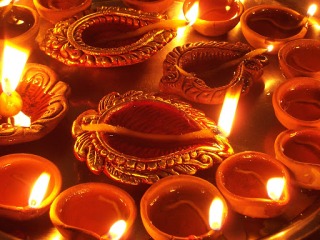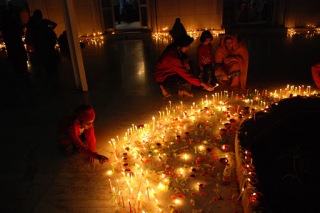Archive | October, 2011
The True Meaning of Halloween: An All Hallows’ Tea
31 OctWhat is the true meaning of Halloween? Have we forgotten, in the debate over the religious correctness of celebrating the holiday, that the true essence of “All Hallow’s Eve” is originally of a spiritual nature? Since the Middle Ages in the British Isles and in ancient Rome, the days from October 31 to November 2 have been associated with acknowledgement of the spirit realm, remembrance of the departed, the harvest, and the restoration of sunlight, celebrated in various ways according to culture. In short, our modern-day “Halloween” is really melting pot of different pagan (meaning “nature- based religion”) celebrations and Christian traditions from Ireland, Scotland and England. Does anyone even know what we’re celebrating anymore?
Samhain: The Celtic New Year
Marking the end of the harvest season and the increasing darkness of Autumn, the night of October 31, known as Samhain (pronounced “sow-wane,” sow as in “how”) in Celtic Irish and Scottish culture is the beginning of the New Year. Samhain is considered the time of year when the veil between the spirit realm and the physical realm is lifted, allowing spirits and human beings to easily communicate and go back and forth between realms. The custom of wearing costumes and masks comes from this Gaelic culture, which on Samhain night people wore to scare away evil spirits and to imitate the dead. They also began the tradition of carving by hollowing out turnips and carving faces on them with candles inside to put in their windows to ward off evil spirits. Even the tradition of trick-or-treating is a Scottish Gaelic custom, with children who would dress in costumes and masks and go around with turnip lanterns to provide entertainments in return for treats and gifts. Scottish and Irish immigration to the United States planted the seeds of the modern-day celebration of Halloween in America.
The Anglo-Saxon Need-Fire Festival
The Need-Fire festival was a pagan celebration in Anglo-Saxon which consequently became part of Celtic culture and the Samhain festival as the Anglo-Saxons invaded Britain. The purpose of the “need-fire” was to restore the dwindling sunlight. Its focus was the lighting of bonfires which were believed to lend power to the sun during the dark months of winter. This tradition evolved into Guy Fawkes Night in Britain in the 17th century, when political rebel Guy Fawkes attempted to blow up the House of Lords in the 1605 anti-monarchist Gunpowder Plot. Guy Fawkes’ Night, also called Bonfire Night, celebrates the night of his arrest and the failure of the plot against James I. It is always a night of fireworks in the United Kingdom.
The Witches’ Sabbath and the Festival of Darkness
For practitioners of Wicca, October 31 beginning at sundown is one of the eight “Sabbats” (or festivals) according to the Wiccan Wheel of the Year. It is the most important Sabbat and night of the year. Drawing on the history of medieval witchcraft, many modern-day Wiccans have adopted the Celtic dates of their ancestors to celebrate their most important days. In the Wiccan religion, October 31 is based on the celebration of Samhain and the tradition of remembering departed loved ones, communicating with spirits, and celebrating the darkness of Autumn (as opposed to Beltane, which celebrates the Spring festival of light). However, witchcraft in general is made up of many beliefs and has many manifestations in different cultures that it is difficult and unfair to speak of it as one tradition. In black magic elements of witchcraft and sorcery, October 31 has historically been a night of coven gatherings not only for devil worship, but for communing with demons and the Devil himself. Since the Middle Ages across Europe, there have been first-hand accounts of sacrifice, black masses, and other profane ceremonies that mock Christianity and focus on Satan worship. Stories of flying witches, traveling spirits and shape-shifting animals on their way to Sabbat coven gatherings date from this time.
All Saints’ Day/All Hallow’s Day: a Christian Celebration
The Roman Catholic celebration of Christian saints on All Saints’ Day dates back to the 8th century, with no association with the Celtic tradition of Samhain. Also known as “All Hallow’s Day,” the term “hallow” means “saint” and is where we derive the modern term Hallowe’en, which is a contraction of All Hallow’s Eve. All Hallow’s Day was originally celebrated on May 13 of each year, as an effort to Christianize (or de-paganise) the Feast of Lemures, or Lemuria, a feast of the dead in the pagan religion of ancient Rome during which the Romans performed rites to exorcise the malevolent and fearful ghosts of the dead from their homes. The date of the All Saints holiday (originally meaning “holy day”) was moved later to November 1st, and All Souls’ Day on November 2nd, perhaps to break any association with the Feast of Lemuria. The Mexican holiday of The Day of the Dead (Dia de los Muertos), is the biggest and most colourful celebration of All Saints’ and All Souls’ Day in the world.
How to Have an All Hallow’s Tea
So how do we celebrate such a complex mix of traditions in our modern day observance of October 31st? What exactly do we call it, when “Halloween” turns out to be a rather narrow term? Here at Myrtle Takes Tea, October 31 through November 2nd is a spiritual festival for filled with activities that celebrate the light-filled spiritual world, especially our ancestors and lost loved ones. We wish everyone a Happy Samhain, a Happy All Hallow’s Eve and finally a Happy Hallow’s Day and Day of the Dead. Here are some ways you can have an “All Hallows Tea” with us:
1) Carve a pumpkin or something more unusual like a turnip or squash to light and put in your window. Nothing is better than glowing pumpkins and lights on All Hallows’ Eve to scare away evil spirits and put a smile on everyone’s face in the neighbourhood! Try a teapot design!
2) Have a party at home! Even by yourself! Or just with your kids or spouse! Steep some spice tea or something else lovely on a chilly October evening, scare yourself silly by watching a movie about spirits and ghosts, pop some popcorn, bake some cupcakes, eat too much candy, and enjoy your glowing pumpkin in the window. If necessary, invite some friends over!
3) Put on a costume and buy some candy! Even if you have nowhere exciting to go, on All Hallow’s Eve you can make other smile by wearing a costume to work or when you go out to do the shopping! Definitely have your costume on for the trick-or-treaters to hand out candy! That’s the fun part, and kids love it! But avoid wearing violent, murderous costumes! It’s supposed to be a light-filled spiritual evening, not an evil one!
4) Most importantly, pull out photos of ancestors, lost family members, loved ones and pets who have passed away and set them up on a table or mantle with plenty of candles. At a time of year where the spirit and physical realm are very close, it is a time to welcome and remember our departed loved ones without sadness. Spend some time praying, meditating, or even talking to departed spirits believing that they can hear you. This “altar” is also the focus of our All Hallow’s Day/All Saints’ Day/Day of the Dead remembrances on November 1st and 2nd.
5) Finally, get ready to celebrate The Day of the Dead the following day by decorating skulls, buying flowers, putting up electric lights and making other decorations and treats for your altar of loved ones! Remember, Halloween is only the eve of the most important day, All Hallow’s Day, which we do Mexican style! But you’ll have to stay tuned for that in tomorrow’s article!
A blessed Samhain, a happy All Hallow’s Eve, and a Happy All Hallow’s Day and Day of the Dead to you all!



















